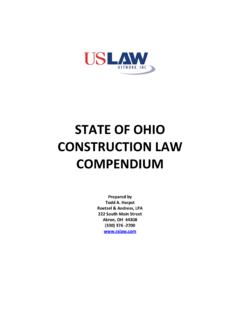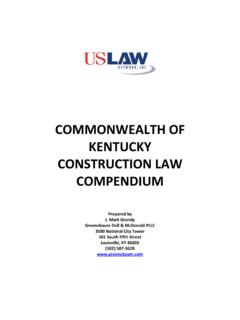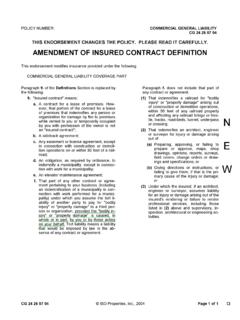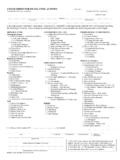Transcription of PART B TORT IN CONSTRUCTION PART A: …
1 Centre of CONSTRUCTION Law/Aeberli. March 2011(rev 1) Web site: - 1 -KINGS COLLEGE LONDON CENTRE OF CONSTRUCTION LAW AND MANAGEMENT part B tort IN CONSTRUCTION Peter Aeberli RIBA ARIAS FCIArb Barrister, Chartered Arbitrator, Adjudicator, CEDR Registered Mediator part A: NEGLIGENCE AND DEFECTIVE CONSTRUCTION WORKS AFTER D&F ESTATES V. CHURCH COMMISSIONERS (1989) AND MURPHY V. BRENTWOOD (1991) Introduction 1. Difficulties in this area concern the circumstances in which a duty of care in negligence will be imposed, and are due to: Multiparty involvement in CONSTRUCTION projects; Interrelationship between obligations in contract or statute and duty of care in negligence; Persistence of caveat emptor rule in real property transactions and preference for full repairing leases; Discontinuities in contractual networks or assignment problems, consider Linden Garden Trust v.
2 Lenesta Sludge Disposals [1994] 1 AC 85, Darlington BC v. Wiltshire Northern Ltd (1994) 69 Build LR1. 1 For a recent application see #Alfred McAlpine v. Panatown [2000] BLR 331 (HL).2 See also #The Contracts (Rights of Third Parties) Act 1999. 1 Linden Garden Contractual bar on assignment without consent, valid, assignment void as between original contract parties. In the McAlpine case, damage occurred after its employer, St Martin, sold the property and purported to give assignment. Held St Martin could recover real damages, even though no property interest at date of breach since knew at time of contract formation was going to be occupied, possibly purchased by third parties, not by St Martin, and no automatic acquisition of rights against purchaser on acquisition, the Albazero [1977] AC 744, principle.
3 Darlington. Assess damages recoverable by assignee on basis that assignment not made and building not transferred. 2 Panatown: Employer did not own land on which building to be constructed and no interest in that land. Building alleged to be defective, could employer recover substantial damages. Discussion of the narrow ground of liability (Albazero principle). Also a broad grounds of liability identified that person who engaged person to provide work and materials and did not receive the contracted for performance suffered a loss, at least where intended to pay for the remedial works. Consideration of whether the duty of care agreement by contractor to the land owner affected these principles. Yes, because neither principle applied where the parties contemplated a direct claim between landowner and contractor.
4 Centre of CONSTRUCTION Law/Aeberli. March 2011(rev 1) Web site: - 2 - Various types of conduct that can cause damage and conceptual difficulties in categorising such damage; Limitation problems due to latency of defects, Soci t Commercial de R assurance v. ERAS (International) Ltd [1992] 2 All ER Attempts by defendants to find a concurrent duty in negligence so can raise issues of contributory negligence, such as in Raflatac Ltd v. Eade [1999] 1 Lloyd s Rep 506. Contrast the position in contract, W Lamb v. Jarvis (1998) 60 Con LR 1, applying Tenant Radiant Heat v. Warrington (1988) 11 EG 71 (CA).4 Generalists and incrementalists 2. These difficulties are compounded by the competing principles used by the courts to determine the existence of a duty of care.
5 The generalist verses the incrementalist approach. Generalists. Lord Atkin, #Donoghue v. Stevenson [1932] AC 562: ".. there .. is, some general conception of relations giving rise to a duty of care, of which the particular cases found in the books are but instances ..". Lord Wilberforce, Anns v. London Borough of Merton [1978] AC 728 (subsequently overruled): "Through the trilogy of cases in this House, Donoghue v. Stevenson, Hedley Byrne & Co Ltd v. Heller & Partners Ltd and Home Office v. Dorset Yacht Co Ltd the position has now been reached that in order to establish that a duty of care arises in a particular situation, it is not necessary to bring the facts of that situation within those of previous situations in which a duty of care has been held to exist.
6 " Incrementalists. Lord Bridge in #Caparo Industries Plc v. Dickman [1990] 2 AC 605: "While recognising, of course, the importance of the underlying general principles common to the whole field of negligence, I think the law has now moved in the direction of attaching greater significance to the more traditional 3 ERAS: LDA 1986, s. 14A applies only where duty arises in tort of negligence (not contractual negligence). 4 Raflatac: 1st D, main contractor, unsuccessfully argued that it was concurrently liable in negligence for 2nd D s (P selected sub-contractor s) failure to consult with P before altering sprinklers (caused flood). Thus, could not raise contributory negligence. Nor did the Tenant principle (see Lamb) apply because no suggestion of a breach of legal duty owned by P to 1st D.
7 (if was court could, applying Tenant, apportion responsibility for the damage between the parties). Centre of CONSTRUCTION Law/Aeberli. March 2011(rev 1) Web site: - 3 -categorisation of distinct and recognisable situations as a guide to the existence, the scope and limits of the varied duties of care which the law imposes." Lord Oliver, #Murphy v. Brentwood [1991] 1 AC 398, 484. The categorisation of the damage is useful: "in identifying those cases in which it is necessary to search for and find something more than mere reasonable foreseeability of damage which has occurred as providing the degree of "proximity" necessary to support the action." A three stage duty test (generalists) 3. The generalists appear to be somewhat in the ascendant (a three stage rather than a two stage test): Savill LJ (in the Court of Appeal), approved by Lord Styne, #Marc Rich & Co v.
8 Bishop Rock Marine Co [1996] 1 AC 211:5 ".. whatever the nature of the harm sustained by the plaintiff, it is necessary to consider the matter not only by enquiring about foreseeability but also by considering the nature of the relationship between the parties; and to be satisfied that in all the circumstances it is fair, just and reasonable to impose a duty of care. Of course .. these three matters overlap with each other and are really facets of the same thing. For example, the relationship between the parties may be such that it is obvious that a lack of care will create a risk of harm and that as a matter of common sense and justice a duty should be imposed.. Again in most cases of the direct infliction of physical loss or injury through carelessness, it is self-evident that a civilised system of law should hold that a duty of care has been broken, whereas the infliction of financial harm may well pose a more difficult problem.
9 Thus the three so-called requirements for a duty of care are not to be treated as wholly separate and distinct requirements but rather as convenient and helpful approaches to the pragmatic question of whether a duty of care should be imposed in any given case." The categories of actionable harm (incrementalists) 4. The categorisation of actionable harm (as opposed to the consequential damage, consider Spartan Steel Alloys Ltd v. Martin & Co [1973] 1 QB 27 or London Waste Ltd v. Amec (1997) 83 Build LR 136),6 particularly the distinction between economic injury 5 Mark Rich: Hague Rules (international convention) limited ship owner s liability to cargo owner. Surveyor allowed un-seaworthy ship to sale, sank. Surveyor not in charge of cargo, no dealings with cargo owners who relied on the ship owners to take care.
10 Proximity relevant despite being a physical damage case (no proximity, not a direct infliction of physical harm case). Not fair and reasonable to allow negligence claims to outflank contract between cargo owners and ship owners governed by Hague Rules. 6 Spartan Steel: No claim for loss of profit on melts not damaged, no damage to furnace itself. Amec Damage to cables to P s premises (waste incinerator), damaged generators. It was conceded such damages were recoverable in negligence. But no claim was allowed for the financial costs of having to dispose of waste elsewhere and consequent loss of profit on sale of electricity. Centre of CONSTRUCTION Law/Aeberli. March 2011(rev 1) Web site: - 4 -and injury to person and property, remains relevant to identifying the different ambit of #Donoghue v.
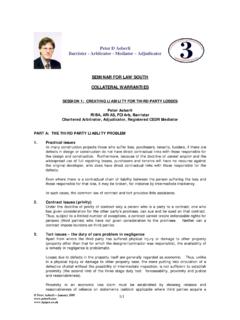
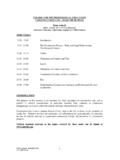
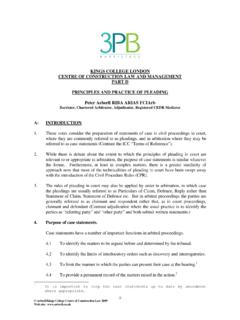

![CLAIMS THE KEY ESSENTIALS [ PART 1 ] - kpkqs.com](/cache/preview/5/b/7/9/c/5/e/1/thumb-5b79c5e12cfb7d73ac152a7099f25fbc.jpg)
